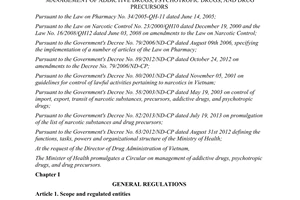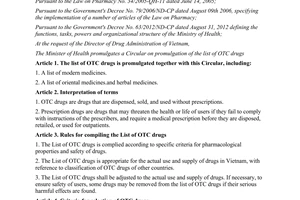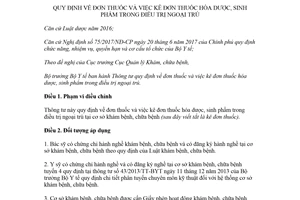Circular 05/2016/TT-BYT regulations prescription outpatient treatment đã được thay thế bởi Circular 52/2017/TT-BYT prescription of modern drugs and biologicals in outpatient treatment và được áp dụng kể từ ngày 01/03/2018.
Nội dung toàn văn Circular 05/2016/TT-BYT regulations prescription outpatient treatment
|
MINISTRY
OF HEALTH |
SOCIALIST
REPUBLIC OF VIETNAM |
|
No.: 05/2016/TT-BYT |
Hanoi, February 29, 2016 |
CIRCULAR
REGULATIONS ON PRESCRIPTION IN OUTPATIENT TREATMENT
Pursuant to the Government's Decree No. 63/2012/ND-CP dated August 31, 2012 defining the functions, tasks, powers and organizational structure of Ministry of Health;
At the request of Director General of Medical Examination and Treatment Administration;
Minister of Health promulgates this Circular to provide for the prescription in outpatient treatment.
Article 1. Scope
1. This Circular provides regulations on prescription in outpatient treatment by State-owned and private health facilities.
2. The following cases are not governed by this Circular:
a) The prescription for traditional medicines and the prescription for traditional medicines integrated with modern medicines;
b) The prescription for substitute drugs in treatment of addicts to opioids.
Article 2. Regulated entities
1. Doctors and physicians who possess practicing certificates of medical examination and treatment (hereinafter referred to as doctors and physicians).
2. Health facilities with licenses for medical examination and treatment activities (hereinafter referred to as health facilities) and drug retailers with certificates of eligibility for sale of drugs (hereinafter referred to as drug retailers).
3. Patients and their relatives who have prescriptions for outpatient treatment.
Article 3. Regulations to be abided by prescribers
1. Prescribers must be doctors.
2. A physician may make up prescriptions if he/she meets all of the following conditions:
a) Possess a practicing certificate of medical examination and treatment, and work at a State-owned district health facility or a clinic of commune/ward/town or organization or school health facility (hereinafter referred to as communal clinic);
b) Have a letter of assignment on medical examination and treatment granted by the head of a district health facility in conformity with the division of levels for medical management in district area.
3. A doctor or a physician who works in a communal clinic may make up prescriptions for diseases of specialties corresponding to the scope of general medical examination and treatment decided in the professional scope of that communal clinic and his/her professional competence.
4. In case of emergency where hospitalization procedures are not completed, the prescriber of any specialty (including traditional medicine) may make up prescription for dealing with such emergency case according to medical state.
Article 4. Prescription principles
1. Prescriptions are made up after having results of medical examination and diagnosis.
2. The prescription must correspond with the medical diagnosis and the extent of disease.
3. The quantity of drugs to be dispensed shall comply with Guidelines for medical diagnosis and treatment adopted by Ministry of Health or be enough for use up to 30 (thirty) days, except for the cases referred to in Articles 7, 8 and 9 of this Circular.
4. A physician may not make up prescriptions for finished combined drugs containing narcotic ingredients, finished combined drugs containing psychoactive ingredients and finished combined drugs containing drug precursors which are not in the List of prescription drugs announced by Minister of Health.
5. The following drugs are not written out in a prescription:
a) Medicines or substances that are not used for medicinal purposes;
b) Medicines which are not licensed for sale in Vietnam;
c) Functional foods;
d) Cosmetics.
Article 5. Forms of making up prescription
1. Prescriptions given to patients who come under medical examination at health facilities:
A prescriber shall write prescription drugs for a patient in a printed prescription form according to the form stated in Annex No. 01 or medical book according to form stated in Annex No. 02 enclosed with this Circular and record names of drugs to be dispensed, their quantity and period of using drugs in health facility’s medical book.
2. Prescription for outpatients:
A prescriber writes a prescription in the outpatient medical record and in the patient’s medical book according to the form stated in Annex No. 02 or long-term treatment book according to the form stated in Annex No. 03 enclosed to this Circular.
3. Prescription for patients who must receive the outpatient treatment upon the completion of inpatient treatment:
a) If a prescriber anticipates that the patient needs taking medicines only from 01 (one) to 07 (seven) days, the prescriber shall continue writing out a prescription in the inpatient medical records and in the patient's medical book or long-term treatment book.
b) If a prescriber anticipates that the patient needs taking medicines for a period longer than 07 (seven) days, that patient shall be considered as an outpatient (the outpatient medical record shall be made) upon the end of his/her inpatient treatment, and the prescription for that patient shall follow regulations in Clause 2 of this Article.
4. The prescription for narcotic drugs, psychotropic drugs and drug precursors shall follow regulations in Articles 7, 8 and 9 of this Circular.
Article 6. General requirements on prescription contents
1. Complete items printed in the prescription form or medical book or long-term treatment book of the patient in a clear and accurate manner.
2. Exactly specify the patient's permanent or temporary address, including house number, street, residential group or hamlet/village, commune/ward/town.
3. If patient is a child aged under 72 months: specify the child’s months of age and full name of the child's father or mother.
4. Write drug names according to the international nonproprietary names (INN, generic), except for the cases where the medicine contains several active ingredients. If a trade name of drug is added in the prescription, it must be specified in the brackets next to its international nonproprietary name.
E.g.: Paracetamol
- Drug name is specified according to the international nonproprietary name: Paracetamol 500mg.
- If its trade name is added: Paracetamol 500mg (Hapacol or Biragan or Efferalgan or Panadol,...) shall be specified.
5. Write drug name, strength/content, quantity, dosage, administration route and time for taking each type of drug.
6. The quantity of narcotic drugs must be specified in words, and the first letter must be capitalized.
7. The quantity of drugs: write “0” in front of the figure indicating the quantity of drug which has the only figure (i.e. smaller than 10).
8. If a prescription is adjusted, the prescriber must confirm by affixing his/her signature next to the adjusted contents.
9. Cross out the blank from the point under the prescription contents to the point above the prescriber’s signature; prescriber must sign and write his/her full name (or affix his/her name seal).
Article 7. Prescription for narcotic drugs
1. Make up the prescription by using “N” prescription form which is stated in Annex No. 04 enclosed to this Circular and made into 03 copies: 01 “N” prescription is retained at the health facility, 01 “N” prescription is included in the patient’s medical book or long-term treatment book and 01 other “N” prescription must be stamped by the health facility and retained at the facility where prescription drugs are dispensed or sold. If prescription drugs are dispensed/sold by the health facility, the prescription does not require the health facility’s stamp.
2. The quantity of drugs in a prescription for an acute disease shall not exceed 07 (seven) days.
3. In case of prescription for narcotic drugs, the prescriber must instruct the patient or the patient’s family (if the patient is unable to come the health facility or the patient is not capable of civil acts) to make a commitment on the use of narcotic drugs. The said commitment must be made according to the form stated in Annex No. 05 enclosed to this Circular and made into 02 copies of same contents, among which one copy is retained at the health facility and the other is given to the patient or the patient’s family.
4. The health facility must prepare a list of sample signatures of prescribers for narcotic drugs and send it to relevant departments inside the health facility.
Article 8. Prescription of narcotic drugs for pain relief in patients with cancer or AIDS
1. If a patient is diagnosed with cancer or AIDS, the health facility shall make outpatient medical record and issue a long-term treatment book to that patient. The prescriber shall instruct the patient or his/her family in completing the commitment on the use of narcotic drugs in page 2 of the long-term treatment book (committed contents are defined in Annex No. 05 enclosed to this Circular).
2. If narcotic drugs are prescribed for paint relief upon the patient’s need for pain relief, the maximum period of each indication for taking narcotic drugs shall be 30 (thirty) days provided that 03 prescriptions must be given for 03 consecutive treatment stages at the same time, in which the quantity of drugs in each prescription for each treatment stage shall not exceed 10 (ten) days (the dates of starting and ending each treatment stage must be specified).
3. In case of prescription for narcotic drugs for pain relief in a patient with terminal cancer or AIDS at home (the patient is unable to come to the health facility): The patient must have a certificate granted by the head of communal clinic where the patient resides to certify that he/she needs using narcotic drugs to relieve his/her pain by using the form stated in Annex No. 06 enclosed to this Circular. The health facility’s doctor shall base on that certificate to make up prescription for that patient. The quantity of narcotic drugs to be dispensed in each prescription shall not exceed 10 (ten) days.
Article 9. Prescription for psychotropic drugs and drug precursors
1. Make up the prescription by using “H” prescription form which is stated in Annex No. 07 enclosed to this Circular and made into 03 copies, among which 01 “H” prescription is retained at the health facility, 01 “H” prescription is included in the patient’s medical book or long-term treatment book and 01 other “H” prescription must be stamped by the health facility and retained at the facility where prescription drugs are dispensed or sold. If prescription drugs are dispensed/sold by the health facility, the prescription does not require the health facility’s stamp.
2. The quantity of drugs to be dispensed in a prescription for an acute disease shall not exceed 10 (ten) days.
3. With regard to diseases requiring long-term treatment (chronic diseases): The prescription shall be given in conformity with Ministry of Health’s guildelines for medical diagnosis and treatment or with the quantity of drugs enough for use up to 30 (thirty) days.
4. Patients with mental illness or epilepsy:
a) The prescription is made up according to the guidelines for medical diagnosis and treatment of relevant specialty;
b) The patient’s family or staff of communal clinic where the patient resides shall be responsible for dispensing/receiving prescription drugs with signature and full name are specified in the communal clinic's record of drug delivery (using the form regulated by relevant specialty);
c) The prescriber shall decide whether a patient with mental illness may himself/herself receive prescription drugs or not.
Article 10. Prescription in health facilities with information technology applications
1. The prescription shall be made up by computer aid, then printed and signed by the prescriber, one copy of which shall be given to the patient in order to keep in his/her medical book or long-term treatment book.
2. “N” prescriptions given as referred to in Clause 1 Article 7 of this Circular and "H" prescriptions given as referred to in Clause 1 Article 9 of this Circular: 03 copies of each prescription shall be printed out for retention.
3. “N” prescriptions given as referred to in Clause 2 Article 8 of this Circular: 06 copies of prescriptions shall be printed out in corresponding to 03 treatment stages in one time of medical examination, where: 03 copies corresponding to 03 treatment stages are retained in the patient's outpatient medical record and 03 other copies corresponding to 03 treatment stages are given to the patient or his/her family.
4. Health facilities that apply information technology to the prescription must guarantee the retention of given prescriptions for data retrieval in case of need.
Article 11. Prescription’s validity
1. A prescription shall be valid for buying/receiving drugs within 05 days from the prescription date.
2. Prescription drugs may be purchased at licensed drug retailers nationwide.
3. The period for buying/receiving prescription narcotic drugs shall correspond with the treatment stage specified in that prescription for narcotic drugs. Narcotic drugs of the second or third treatment stage of a patient with cancer or AIDS must be bought or received at least 01 (one) to 03 (three) days before each treatment stage (if such days fall into public holidays, new year days, Saturdays or Sundays, prescription drugs must be bought or received in days preceding or following the day off).
Article 12. Return of unused narcotic drugs, psychotropic drugs and drug precursors
1. Patients or their families must return unused narcotic drugs, psychotropic drugs and drug precursors to the facilities where drugs are dispensed or sold.
2. Facilities dispensing or selling drugs must make written records of receipt of narcotic drugs, psychotropic drugs and drug precursors returned by patients or their families, using the form stated in Annex No. 08 enclosed to this Circular. The written record must be made in 02 copies (01 is retained at the facility dispensing/selling drugs and the other is deliver to the person returning drugs).
3. The returned narcotic drugs, psychotropic drugs and drug precursors must be separately stored and handled in accordance with regulations of the law on pharmacy.
Article 13. Retention of prescriptions and documents relating to narcotic drugs, psychotropic drugs and drug precursors, and prescriptions for antibiotics
1. Health facilities must retain prescriptions for 01 (one) years from the date on which a prescription is given.
2. “N” prescriptions, written commitments on use of narcotic drugs and “H” prescriptions must be retained at health facilities for 02 (two) years from the drug expiration date.
3. Facilities preparing/dispersing/retailing narcotic drugs, psychotropic drugs and drug precursors must retain all “N” prescriptions and “H” prescriptions. The retention period is 02 (two) years from the drug expiration date.
4. Facilities preparing/dispersing/retailing drugs must retain prescriptions which contain antibiotics for 01 (one) year from the prescription date. The retention of prescriptions shall be made in one of the following forms:
a) Retain the original or copied prescriptions;
b) Retain information about each prescription, consisting of: health facility’s name and address, prescriber’s full name, the patient’s full name and permanent address, name, content and quantity of antibiotics.
5. When the retention period of documents about narcotic drugs, psychotropic drugs and drug precursors, relevant facilities must establish document destruction councils as referred to in the Circular No. 19/2014/TT-BYT dated June 02, 2014 providing for the management of narcotic drugs, psychotropic drugs and drug precursors. Documents to be destructed: “N” prescriptions, “H” prescriptions, written commitments on use of narcotic drugs, written records of receipt of returned narcotic drugs, Certificates certifying that patients needs using narcotic drugs for pain relief made by communal clinics (if any).
Article 14. Implementation
1. Medical Examination and Treatment Administration affiliated to Ministry of Health shall instruct and organize the implementation of this Circular as well as inspect and evaluate the implementation thereof.
2. Departments of health of central-affiliated cities or provinces, health agencies of Ministries/regulatory bodies shall assume the following responsibilities:
a) Instruct and organize the implementation of this Circular within their management regions;
b) Inspect and evaluate the implementation of this Circular within their management regions;
c) Instruct the organization of sellers of narcotic drugs to outpatients. With respect to provincial urban/suburban districts, towns and cities where sellers of narcotic drugs are not available, pharmacy departments of local hospitals must provide (according to buying price) narcotic drugs to outpatients in order to ensure that they can take enough narcotic drugs as prescribed.
d) Send notice to local health facilities and relevant agencies of lists of facilities dispensing/selling narcotic drugs.
3. Health facilities and drug retailers shall assume the following responsibilities:
a) Implement regulations in this Circular.
b) Receive narcotic drugs, psychotropic drugs and drug precursors returned by patients or their families, and destruct drugs as referred to regulations in the Circular No. 19/2014/TT-BYT dated June 02, 2014 providing for the management of narcotic drugs, psychotropic drugs and drug precursors.
c) Drug retailers are only allowed to sell drugs which are not in the list of OTC drugs enclosed to the Circular No. 23/2014/TT-BYT dated June 30, 2014 by Ministry of Health on the promulgation of the list of OTC drugs to buyers who are given with prescriptions as referred to in this Circular;
d) Narcotic drug retailers shall sell narcotic drugs to patients only when they have “N” prescriptions as referred to in Articles 7 and 8 of this Circular.
4. Responsibilities of prescribers:
a) Implement regulations on the prescription in this Circular and assume responsibility for their prescriptions given to patients;
b) Provide instructions for use of drugs, advice on diet and daily activities to patients or their families; request the patients or their families to immediately inform the prescribers or nearest health facilities when patients have any abnormal signs or symptoms after taking medicines.
5. Patients and their families must comply with regulations in this Circular.
Article 15. Effect
1. This Circular takes effect as of May 01, 2016.
2. Decision No. 04/2008/QD-BYT dated February 01, 2008 by Minister of Health providing for the prescription in outpatient treatment shall be null and void as of the effective date of this Circular.
Difficulties that arise during the implementation of this Circular should be reported to the Ministry of Health (via Medical Examination and Treatment Administration) for consideration./.
|
|
PP.
MINISTER |
------------------------------------------------------------------------------------------------------
This translation is made by LawSoft and
for reference purposes only. Its copyright is owned by LawSoft
and protected under Clause 2, Article 14 of the Law on Intellectual Property.Your comments are always welcomed



